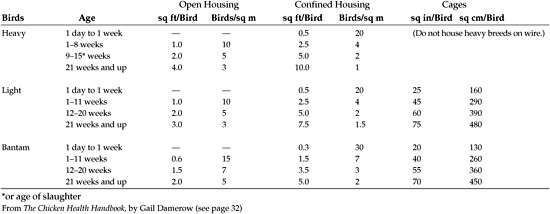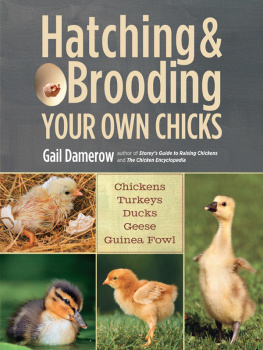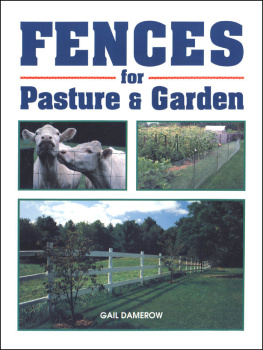Building Chicken Coops
Excerpted from
A Guide to Raising Chickens,
by Gail Damerow
CONTENTS
Introduction
Chicken-coop designs are as varied as the people who keep chickens. The best design for you depends on how many chickens you keep, your purpose in keeping them, their breed, your geographic location, and how much money you want to spend. A handy way to get ideas is to find successful chicken keepers in your area or correspond with those who live in a similar climate and pick their brains as to what works and what doesnt.
Twelve Tips for a Successful Coop Designimage
Some people provide their flocks with perfectly adequate housing by converting unused toolsheds, doghouses, or camper shells. Others go all out, such as the fellow I knew in California who built a two-story structure, complete with a cupola, for his fancy bantams.
No matter how its designed, though, a successful coop:
 is easy to clean
is easy to clean
 has good drainage
has good drainage
 protects the flock from wind and sun
protects the flock from wind and sun
 keeps out rodents, wild birds, and predatory animals
keeps out rodents, wild birds, and predatory animals
 provides adequate space for the flock size
provides adequate space for the flock size
 is well ventilated
is well ventilated
 is free of drafts
is free of drafts
 maintains a uniform temperature
maintains a uniform temperature
 has a place where birds can roost
has a place where birds can roost
 has nests that entice hens to lay indoors
has nests that entice hens to lay indoors
 offers plenty of light natural and artificial
offers plenty of light natural and artificial
 includes sanitary feed and water stations
includes sanitary feed and water stations
Ensuring Good Drainage
If your soil is neither sandy nor gravelly, locate your coop at the top of a slight hill or on a slope, where puddles wont collect when it rains. A south-facing slope, open to full sunlight, dries fastest after a rain. Capture that light and warmth from the sun inside the coop with windows on the south side.

This basic coop plan features roosts over a droppings pit for good sanitation, a window for light, and screened and shuttered openings on the north side to control ventilation. To expand the interior floor space, build the nests on the outside of the coop (see page 12).
Planning for Easy Access
Simple, open housing is easier to clean than a coop with numerous nooks and crannies. If your coop is tall enough for you to stand in, youll be inclined to clean it as often as necessary. If you prefer a low coop (for economic reasons or to retain your flocks body heat in a cold climate), design the coop like a chest freezer, with a hinged roof you can open for cleaning.
The coop should have both a chicken-sized door and a peoplesized door. The chicken door can be a 10-inch-wide by 13-inch-high (25 32.5 cm) flap cut into a side wall, opening downward to form a ramp for birds to use when they enter and exit. To keep predators out, the door should have a secure latch that you can fasten shut in the evening, after your chickens have gone to roost.
Space Requirements
The more room your chickens have, the healthier and more content theyll be. Except in extremely cold climates, home flocks are rarely housed entirely indoors but have room to roam outside whenever they please. Yet even in the best of climates, chickens may sometimes prefer to remain indoors due to rain, extreme cold, or extreme heat.
Minimum space requirements, including those shown in the chart below, indicate the least amount of indoor space birds need when they cant or wont go outside for an extended period of time. Birds that never have access to an outside run will do better if you give them more space than the absolute minimum. On the other hand, birds that spend most of their time outdoors, coming in only at night to roost, will do nicely with less space.
To encourage chickens to spend most of their daytime hours outdoors, even in poor weather, give them a covered area adjoining the coop where they can loll out of rain, wind, and sun. Encouraging your chickens to stay out in the fresh air has two advantages: They will be healthier, and their coop will stay cleaner.
Minimum Space Requirements

Providing Adequate Ventilation
The more time chickens spend indoors, the more important ventilation becomes. Ventilation serves six essential functions:
 supplies oxygen-laden fresh air
supplies oxygen-laden fresh air
 removes heat released during breathing
removes heat released during breathing
 removes moisture from the air (released during breathing or evaporated from droppings)
removes moisture from the air (released during breathing or evaporated from droppings)
 removes harmful gases (carbon dioxide released during breathing or ammonia evaporated from droppings)
removes harmful gases (carbon dioxide released during breathing or ammonia evaporated from droppings)
 removes dust particles suspended in the air
removes dust particles suspended in the air
 dilutes disease-causing organisms in the air
dilutes disease-causing organisms in the air
Ventilation Quick Check
Use your nose and eyes to check for proper ventilation. If you smell ammonia fumes and see thick cobwebs, your coop is not adequately ventilated.
Compared to other animals, chickens have a high respiration rate, which causes them to use up available oxygen quickly while at the same time releasing large amounts of carbon dioxide, heat, and moisture. As a result, chickens are highly susceptible to respiratory problems. Stale air inside the henhouse makes a bad situation worse airborne disease-carrying microorganisms become concentrated more quickly in stale air than in fresh air.
Ventilation holes near the ceiling along the south and north walls give warm, moist air a way to escape. Screens over the holes will keep out wild birds, which may carry parasites or disease. Dropdown covers, hinged at the bottom and latched at the top, let you close off ventilation holes as needed.
Cold-Weather Concerns
During cold weather, you not only have to provide good ventilation, but you also have to worry about drafts. Close the ventilation holes on the north side, keeping the holes on the south side open except when the weather turns bitter cold.
Warm-Weather Concerns
Cross ventilation is needed in warm weather to keep birds cool and to remove moisture. The warmer the air becomes, the more moisture it can hold. In the summer, leave all the ventilation holes open and open windows on the north and south walls. Windows should be covered with -inch (1.9 cm) screen to keep out wild birds and should slide or tilt so they can be opened easily. Provide at least 1 square foot of window for each 10 square feet of floor space (or 1 sq m of window per 10 sq m of floor space).




 is easy to clean
is easy to clean
